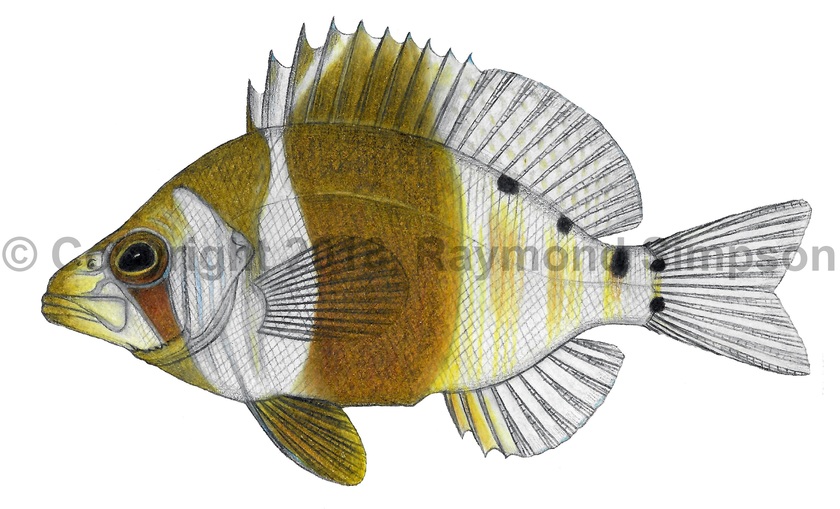
Common Name
Yucatan Hamlet
Year Described
Victor, 2012
Identification
Dorsal Fin: X, 14-15
Anal Fin: III, 7
Pectoral Fin: 13-14
Pelvic Fin: I, 5
Lateral Line: 52
Gill Rakers: 5-6 (upper), 12-13 (lower) on first arch, 17-19 total
Body robust and laterally compressed. Steeply sloping head profile. Dorsal fin continuous with no obvious notch between spiny and soft portions. Anal fin much smaller than dorsal fin. Caudal fin is typically truncate to slightly emarginate. The mouth is large and terminal, with the lower jaw often slightly projecting. Jaws bear villiform teeth, with an inner band of enlarged canines. Scales are ctenoid and cover the body and much of the head. The lateral line is continuous and curves gently along the upper body.
Color
Body whitish grading to yellow ventrally. Pattern very close to H. puella in having multiple brown body bands. The dominant band is the second mid-body one which is very wide and dark. The first band runs behind the opercle and is relatively faint. The third through fifth bands are very faint. A few random black spots mark the areas where the rearmost bands would be. There are two symmetric black spots on the posterior caudal peduncle that remain even in adult fish. The brown band under the eye is heavily infused with yellow, giving it an orange color. There are numerous vertical pale blue lines and spots on the head and anterior body. The fins are pale yellowish. The pelvic fins are golden to dusky brown, with a blue anterior margin.
Size
Maximum size to 83mm SL.
Habitat
Shallow reef habitats.
Range
Known only from the southern Gulf of Mexico off the northern Yucatan Peninsula (Contoy).
References
Victor, B.C. 2012. Hypoplectrus floridae n. sp. and Hypoplectrus ecosur n. sp., two new barred hamlets from the Gulf of Mexico (Pisces: Serranidae): more than 3% different in COI mtDNA sequence from the Caribbean Hypoplectrus species flock. Journal of the Ocean Science Foundation v. 5: 1-19.
Other Notes
Victor (2012) states: “The H. floridae clade differs from the Caribbean clade by 3.76% on average (SE=0.002; minimum distance of 3.39% and maximum distance of 4.37%). The H. ecosur clade differs from the Caribbean clade by 3.23% on average (SE=0.008; minimum distance of 3.0% and maximum distance of 3.83%). The H. floridae and H. ecosur clades differ by 1.41% on average (SE=0.011; minimum distance of 1.24% and maximum distance of 1.72%)”. The clade of H. ecosur and H. floridae is distinct from the clade containing the other Hypoplectrus species according to mitochondrial evidence (CO1 gene), and the two are more distinct from each other than any of the studied Caribbean species are to each other.
More study with complete taxon sampling, many specimens from all over the Caribbean, and for multiple genes are required to determine just how many “species” of Hypoplectrus actually occur in the Caribbean Sea. The species are morphologically almost identical, and have weak genetic signatures indicating a recent radiation.